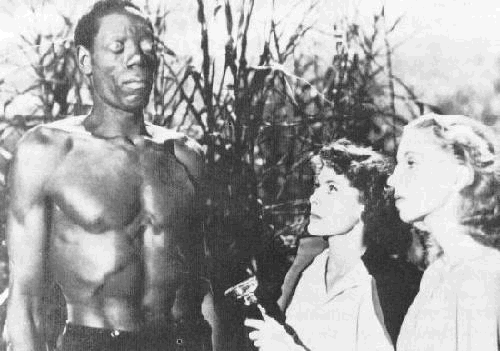
We watched 'I walked with a Zombie' on the 21st of October 2008, and the film was made in 1943; a collaberation between Val Lewton and Jaques Turnier. The premise of the film:
Plot: A young Canadian nurse (Betsy) comes to the West Indies to care for Jessica, the wife of a plantation manager (Paul Holland). Jessica seems to be suffering from a kind of mental paralysis as a result of fever. When she falls in love with Paul, Betsy determines to cure Jessica even if she needs to use a voodoo ceremony, to give Paul what she thinks he wants. - Adapted from IMDB.COM.
The atmosphere induces low-key lighting to create a tense environment. The boat scene at the start makes references to diegetic sound in narrative, and non-diegetic in the sound of the arteficial rain. The scene in the jungle feature a shot from the first person view, showing the two characters walking through the reeds, with a rustling wind clearly added for dramatic effect. Music is added when appropriate, with the drums and conch of the congo present.Character is established in I Walked with a Zombie effectively, as each of the many characters have a surreal twist to their involvement in the plot. Whether it's the paralysed Jessica, who always looks like a blank slate in need of illustrating, to the African guardian whose eyes are pure white, the characters are all equally bizarre and dream-like, to create a sense of mystery to the plot, and the progression of the characters within it. In terms of mise-en-scene, the female characters wear long dresses, and the casting is centered around popular actors of the era. The men are attired in suits and posh clothing, to enforce their wealth and power in the story, though the women are the main characters of the piece. Betsy and Jessica come off as the strongest and most independant, even if Jessica is unable to speak, and therefore intially seems vulnerable. Camera angles are shown close-up, to highlight the events of the movie, and low-key lighting, particularly in the tower scene where Jessica is first introduced, is used fluently. We see low-key lighting especially in the jungle as well, with shadows playing a key role in setting the scene. There is diegetic sound in that the wind seems overly raucous, yet it creates a sinister tone, enforced by the drums of the congo.
The introduction shows the lead character giving a monologue, almost joking with the viewer that '[she] walked with a Zombie', as if it's the most farfetched thing imaginable. There are archaic chants in the background, with a clear, warm palette serving as the backdrop as the sky is seen. The pleasant background leads the viewer into a false sense of security, and is not representative of the rest of the film. The story acts as a personal recount of the lead characters adventure as a nurse on the island, and her voice-over is non diegetic. She is well-dressed, and clearly of a high standard, as she is going for a well paid job, and is willing to move to a different country for it.
As she is on the ship to the island, there is atmospheric singing from the crew, creating a tense, swashbuckling mood. As she arrives at the compound, there are blinds with shadows seeping through, similarly seen in 'Double Indemnity', and these show her almost to be trapped within a cage. Music tenses up as she moves towards the tower where she can hear crying. The lights cut out around her, though the window blinds remain illuminated, showing their important in setting the scene. Shadows are cast across the leads face, and we can see her obvious fear from the crying in the night. A point-of-view shot is incorporated to show what she see's through the window. The patient is in the forbidden tower, and as she moves up the stairs anxiously, the slow-pace of the film builds, as does the tension of what might happen to her. To the viewer, it is difficult to see what is going on within the tower, and as Jessica walks towards her, the whiteness of her dress makes her appear as a revenant, and the ghost of the piece. This scene is accompanied by string instruments at a quick pace, creating a scary sense of terror as the 'Zombie' moves towards Betsy. Supernatural occurances happen frequently at the compound, and as the country was once in slavery, it is said that the 'women still weep'. The sound of the crying during the night is terrifying to behold, and it creates a darker tone of emotional dread.
The locals are seen singing whilst Betsy is at a restaurant, and the sheriff asks them to stop, finding their words to be frightening and inappropriate. The singing local acts as a narrator, moving closer to the main character through the darkness, his eyes wide and transfixed upon her, as he prophesises what will happen to her. As Jessica's husband, Paul, begins to confess his inner emotions to her, the music grows meloncholy and melodic, in a typically old-fashioned way portraying sentiment. He then becomes hard-shelled again, and the violins create a moody atmosphere. The film ensues with contrasting emotions, and much of 'I Walked with a Zombie's' appeal comes from character development, and well-thought out plot progression over fast-paced action. 'I Walked with a Zombie' is subtle and brooding; a foreboding insight into the darker corners of Film Noir.

'I walked with a Zombie' contains some chilling scenes, for example this shot of the Zombie with the lead heroine.
RKO pictures made this film.


